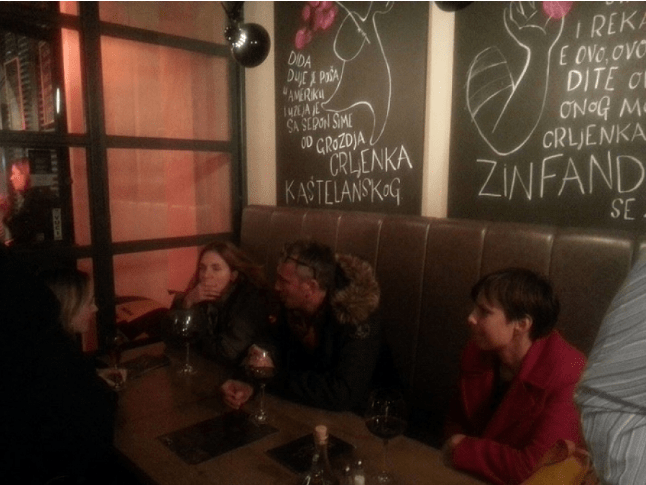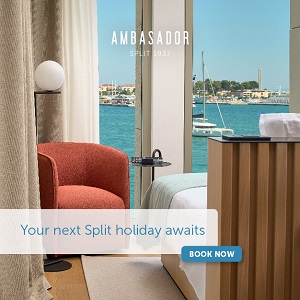Oliver Dragojević: Remembering the Legend on His 71st Birthday
December 7, 2018 - Oliver Dragojević was born today in 1947 in Split, though he was originally from Vela Luka, where he also spent his childhood. Oliver was particularly connected with Split where he attended music school, and also made the first steps in his musical career, reports Dalmacija Danas.
His first encounter with music was at the age of five when his father Marko gifted him an accordion. Oliver would entertain passersby on his street, and boat passengers on the regular Split-Vela Luka route. His first feature appearance was at the Split Children's Festival in 1961 with the popular song 'Baloni'.
Oliver’s festival debut was at the Split Festival in 1967. He attended at the invitation of Zdenko Runjić and played the song 'Picaferaj'. Though the song did not make it to the final festival night, it became one of his eternal hits.
Throughout his lifetime, Oliver’s voice and modesty delighted his fans at concerts all over the world, and it was not unlike him to perform at humanitarian concerts to help those most in need. It was at HNK Split where he took part in the concert "Believe in Love" organized by the County Cancer League for 50 years of dedicated work. The concert was held in October 2017.
However, no one knew that it would be the last public performance of the legendary Oliver Dragojević, whose words after the concert certainly confirm why he was an audience favorite and someone whose songs will remain forever written in the souls of not just Split people, but his admirers around the world.
“Here’s something that works for the people, and that is helping anyone in need. That's a message - believe in love. Being a man is hard, and finding himself is even harder,” Oliver said at the end of the concert.
Oliver had planned to celebrate his 70th birthday with a great concert in Split, where he hoped to mark 50 years of his career, though his illness, unfortunately, prevented him from performing and the concerts were finally canceled.
A few months later, in March this year, Oliver addressed his fans at the Porin, where he was honored with the lifetime achievement award, reports Index.hr.
“I would like to mention a man who marked half my life, and that is Zdenko Runjić. There are a lot of good people around me, and this time the disease has stopped me from being with you. As a child, I wanted to play and sing, and that dream was somehow interrupted. Hello to all the good people around me and those who have supported me in this crisis. I hope there is still time for me to sing and play, and if things get better, it will be good,” Oliver said via a video message.
"What should I say to you - enjoy, people, because life will be a fantasy," Oliver said from his home for the last time, receiving huge applause.
Oliver was born December 7, 1947, and died on July 29, 2018. Oliver is buried in his beloved Vela Luka.
To read more about Oliver, follow TCN's dedicated page here.
NGO CEDRA Split Launches New Incubator in Style
December 6, 2018 - Last week, local NGO CEDRA Split launched a new incubator in style at Hotel Cornaro. Over 70 people packed inside the conference room to hear about the new initiative for young people to firstly learn business skills before developing their own business as part of an incubator for local youth and entrepreneurs.
Christian Grotnes Halvorsen, the First Secretary of the Norwegian Embassy, kicked off the event and emphasised the importance of working together. He explained how the embassy is currently working together with Croatia to create a stronger and reciprocal partnership. He also encouraged those interested to apply and not to worry about potential failure or even their fear of failure.
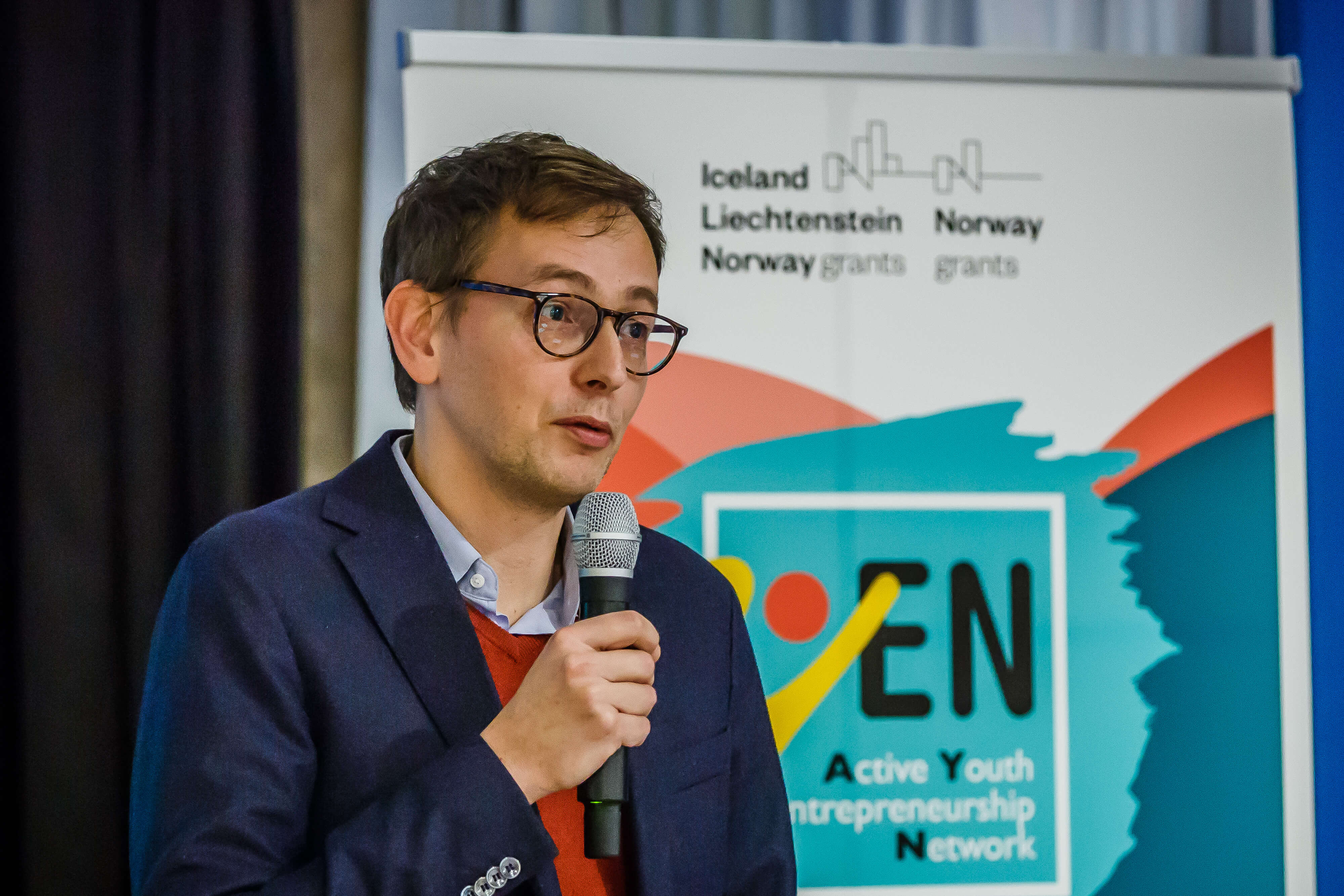
His speech was followed up by two successful entrepreneurs from Dalmatia. First, Ante Dagelić from GetByBus, who shared his story of how, thanks to a great idea and team, they have managed to develop an impressive firm. Afterward, Marin Cokarić from Hotel Krilo and BitCro, talked about the highs and lows of starting a business as well as his more recent move into mentoring local young people in following their dreams.
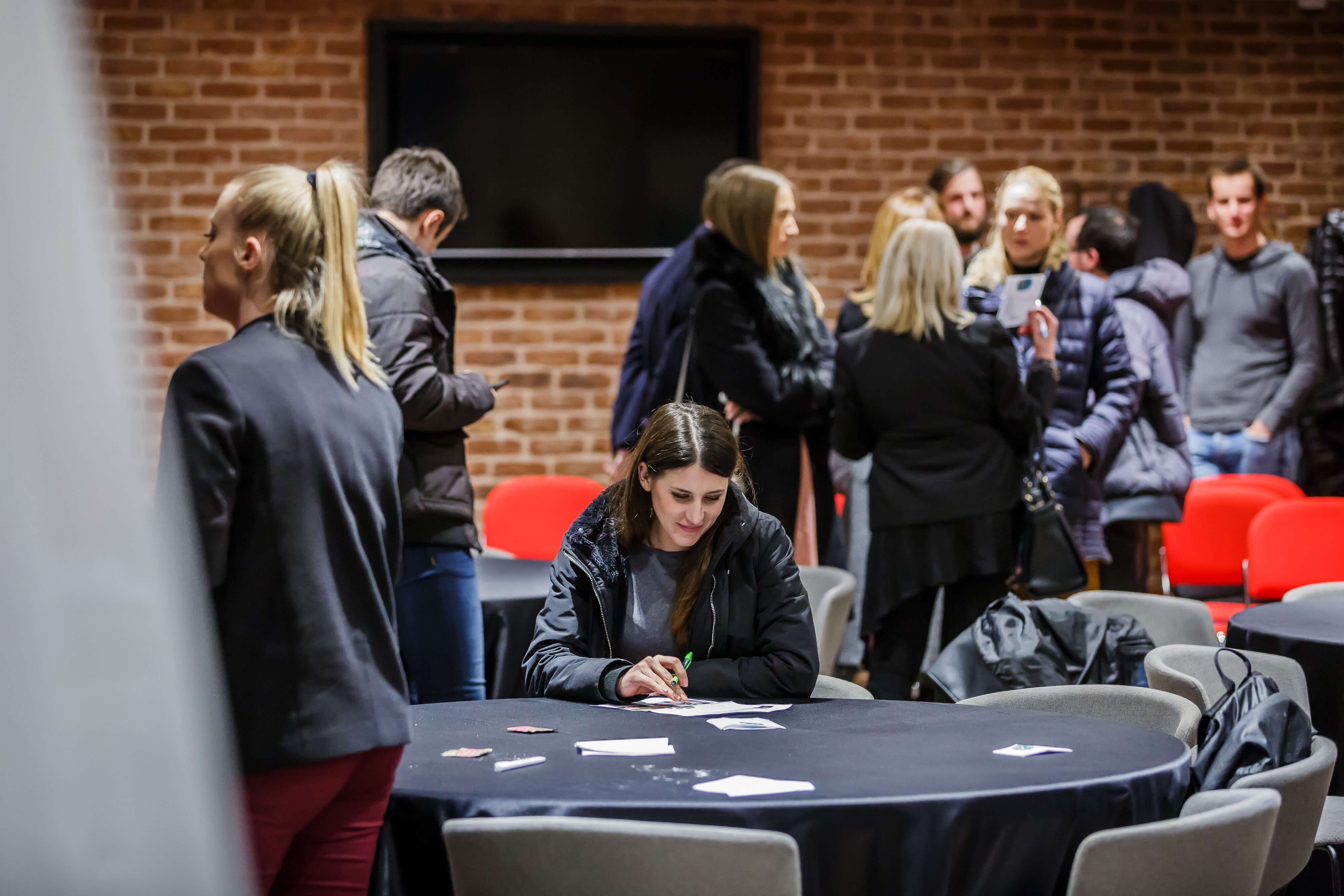
The rest of the event focussed on the incubator itself, and the target groups it will reach over the next 24 months. There will be two recruitment rounds, each with 30 spaces for youth aged 20 – 29, who are currently not in education or employment but based in Dalmatia. Anyone who meets these criteria is encouraged to apply, no matter what your educational background, nationality or business knowledge is.
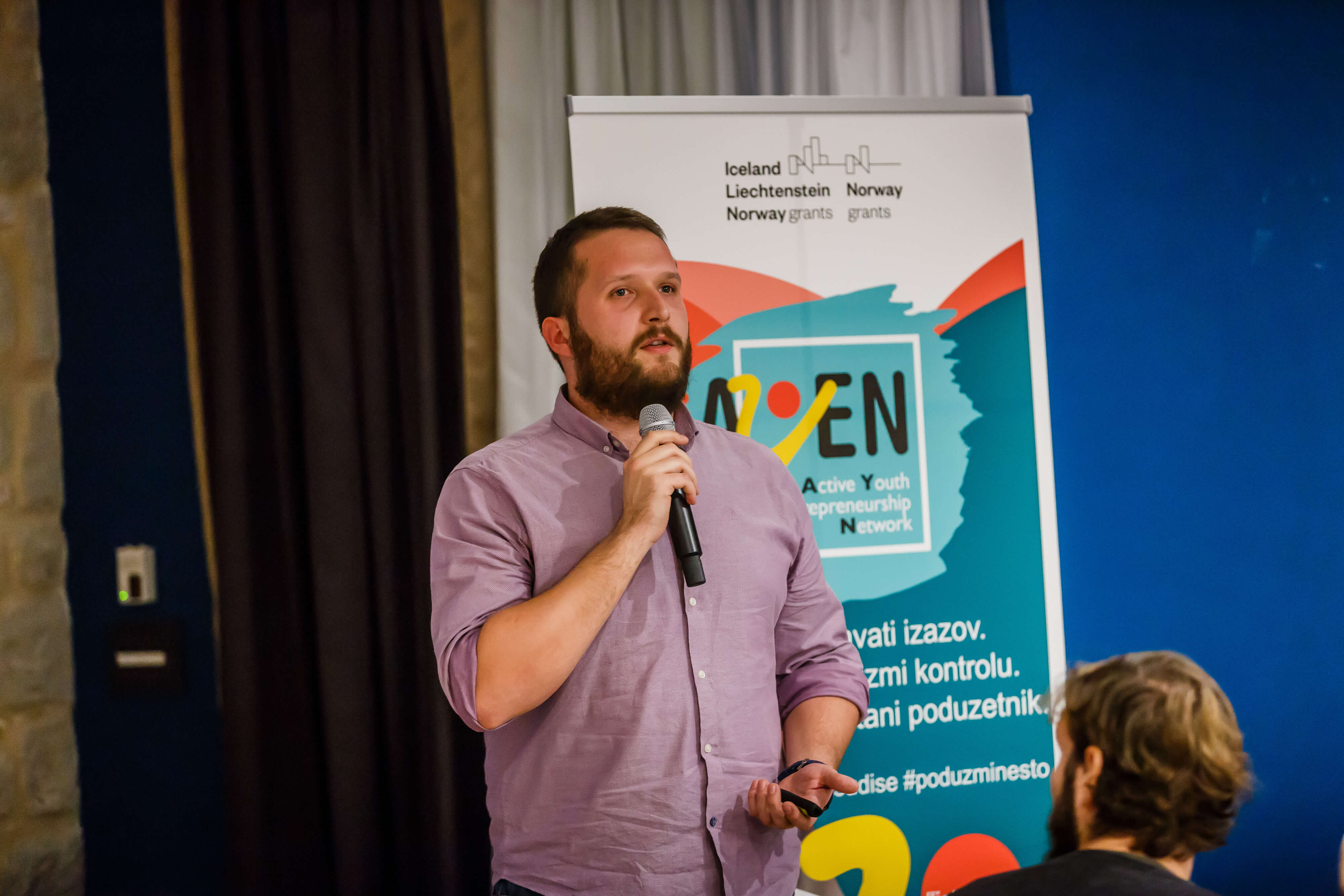
After two months of training, the participants will then be mentored and coached in developing their business ideas further, working in teams and if all things go well, setting up their own enterprise. They will also have the opportunity to travel to one of the partner countries to learn more and share their own idea, as well as having support accessing finance and investors.

Furthermore, AYEN is going to host the first Split business angel meetup on January 24th. This is for anyone in Split looking to invest their time or money into a local startup, and those who are keen can become a volunteer mentor on the program, taking on their own young entrepreneurs and shaping the local talent.
The application stage is now open to all young people, so you can apply here.
For any other information, keep an eye on their Facebook page or contact them via This email address is being protected from spambots. You need JavaScript enabled to view it..
The project “Active Youth Entrepreneurship Network” is funded by Iceland, Liechtenstein and Norway through the EEA and Norway Grants Fund for Youth Employment
To learn more about the events in Split, follow TCN's dedicated page here.
Brasserie on 7 Rolls Out Winter Menu with Advent Twist
December 6, 2018 - Have you made it to Brasserie on 7 yet this winter?
45 New Hotels for Dalmatia and 1,500 Hotel Beds for Split in 2019?
There has never been a more significant investment boom in the hotel sector, especially in southern Croatia. At dozens of sites all over Dalmatia, construction is either underway or nearing completion on more than 45 new hotels which will bring about 6,000 brand new hotel rooms and 13,000 new beds on the market in 2019 alone, reports Slobodna Dalmacija on December 4, 2018.
The total investment in tourism for 2019 is estimated at EUR 1.050 billion, or EUR 100 million more than this year. Of this amount, one third will be invested in four Dalmatian counties, or EUR 314 million in tourism projects. The real star for investors next year is Split-Dalmatia County, which will see EUR 197 million in tourism investment. The city of Split, however, is the most attractive to investors. Works are nearing their end on up to four 4-star hotels, which should, according to the investors, open their doors next spring - and documents have been collected for another five buildings!
According to a survey made by the Ministry of Tourism including the largest hotels in the country on their investment plans for 2019, companies will invest around EUR 626 million in tourism projects, while the public sector, i.e., counties and cities, will spend a total of EUR 425 million in tourism in the next year.
Investments in the private sector include hotels, camps, nautical tourism and other types of accommodations, facilities and attractions. This is precisely why Minister of Tourism Gari Cappelli pointed out that in the last two years, Croatia has seen a growth of 40 percent, and next year a new increase in tourism investment has been announced.
According to investment data from the Ministry of Tourism survey, the most substantial amount of total investments is planned in Primorje-Gorski Kotar County, with a total of EUR 203 million, along with Split-Dalmatia County, with an EUR 197 million investment. Istria will see an EUR 175 million investment in tourism. In continental counties, including the city of Zagreb, EUR 355 million will be invested.
Split-Dalmatia County announced research by audit and consulting firm Ernst Young (EC), according to which in the next five years (2018-2022), Croatia expects record investments in the hotel industry. According to their estimate, by 2022, investments will include a total of 9,700 hotel rooms, of which nearly 6,000 will be new rooms in 4 and 5-star hotels. Most of the hotels will open in Split, which chronically suffers from the lack of hotel beds. Eight new larger hotels and a host of smaller hotels would absolutely fix this image.
Next year, Split will receive the first "Marriott International" hotel in Croatia under the brand "Courtyard by Marriott”, which will open in the "Dalmatia Tower" of the Westgate complex. The new hotel will boast 190 rooms and four suites. At the beginning of the 2019 season, hotel "Amphora Resort" will open on Žnjan. An investment by Split entrepreneur Zvonko Kotarac, the hotel will have a total of 207 rooms, a large congress hall, a series of catering facilities, three swimming pools, and a luxurious wellness area.
The new "Radisson Blu Resort" pavilion, with 54 rooms and 15 suites, was erected at the former hotel “Split” complex. At the site of the former Kaliternina at Bačvice, construction is nearing its end on a hotel which will have four floors with 60 rooms and 45 parking spaces.
At the site of the former "Ambassador" hotel, Klaus Alex Birkenstock invested EUR 17 million. The new "Ambassador" will have 101 rooms and suites, 240 for restaurant seating, a spa, gym, nightclub and underground garage with 59 spaces. The hotel will boast 4+ stars, and should open in the summer of 2019. On the plot located east of the bridge connecting Split and Bačvice, construction is underway on “Vila Harmony" which will have six floors and 26 rooms after an investment of HRK 32 million.
With the completion of all these investments, which plan to receive their first guests in 2019, Split should boast around 1,500 new top hotel beds in exceptional locations, though it is not yet the desired 5,000 hotel beds, or even close to the 24,000 in family accommodation.
Dubrovnik and Šibenik-Knin counties announced symbolic investments of seven or nine million euros in smaller facilities for next year, while Zadar County will invest more than EUR 100 million in tourism for reconstruction and adaptation, the construction of smaller facilities and marina infrastructure.
In addition to those that will be completed in 2019, many of the major tourist projects are still in the process of getting the documentation prepped, such as the “Kupari Resort”, which should see an investment of HRK 700 million. We are also still waiting for the “Four Seasons" in the bay of Brizenica near Stari Grad on Hvar, which will have 120 rooms and around 100 villas, worth a billion kuna.
According to the announcement of the Minister of State Property Goran Marić, an investment of EUR 50 to 70 million is expected for Dubrovnik's Hotel Maestral, while Split's Duilovo expects an HRK 1.5 billion tourist investment after privatization. Privatization is also expected for the Children's Village in Krvavica on the Makarska Riviera, the "Pašman Resort", the Prevlaka Fortress, the "Czech Villa" on Vis, and others.
To read more about Dalmatia, visit TCN's dedicated page here.
Flights to Croatia 2019: Ryanair Announces Dublin to Split and Dubrovnik
December 3, 2018 - Eleven years after entering the Croatian market in Zadar, a great addition to the flights to Croatia 2019 story: Ryanair to Split and Dubrovnik.
Flights to Croatia 2019 just got easier for Irish tourists (and the growing Croatian diaspora in Ireland), as Ryanair has announced two new routes to the Adriatic for next summer - Dublin to Split and Dubrovnik, reports the Irish Independent.
TCN reported 3 weeks ago that Ryanair was in discussions with Split and Zagreb, while the Irish carrier has been talking to Dubrovnik for some time. The sticking point for both Split and Dubrovnik in the past has been giving preferential pricing treatment to Ryanair, whose successful business model is well-known.
It is 11 years since Ryanair changed the landscape in Croatian aviation - and Zadar in particular - by pioneering low-cost flights to the former Dalmatian capital. And yet, while Ryanair took a march on its rivals 11 years ago, it has never really capitalised on that early success. Zagreb, Split and Dubrovnik have remained closed to Ryanair's planes. In the interim, easyJet has become the second most popular airline in Croatia.
Until today.
The Dublin flights to Split and Dubrovnik will commence in June, and we will bring you more details of the schedule as we have it. You can follow the TCN Flights to Croatia 2019 page here. With both Split and Dubrovnik booming and not needing to give financial concessions, and with Ryanair famous for extracting the best deals, it would be interesting to see the fine print of the detail, not that I expect it to be made public.
One airline which may be less than happy by the news is Croatia Airlines, which is already struggling, and the arrival of Europe's most successful airline in the two biggest tourists airport in the country will hardly be welcome news.
First Marriott in Croatia to Open Doors in Split Before 2020
After the construction of the tallest skyscraper in Croatia came to a halt, works on the unfinished northern tower of the Westgate project in Split should be revived.
Can Dalmatian Hinterland Expect Significant Tourism Growth?
While having increased in popularity over the last couple of years owing primarily to active tourism, the Dalmatian hinterland tends to live in the shadow of its coastal cousin, but is all that about to change?
As Poslovni Dnevnik writes on the 3rd of December, 2018, the calculations of the Institute for Croatian Tourism show that the number of overnight stays in Split-Dalmatia County could rise by 30 percent, mostly in the Dalmatian hinterland, by more than 200 percent. The study in which these figures were presented was entitled "Measuring Sustainability of Tourism in Practice".
Tourism Institute researcher Zoran Klarić explained that Split-Dalmatia County tourism would be able to achieve a presumed growth of 30 percent, but only if certain obstacles are dealt with and removed before that goal, Slobodna Dalmacija reports.
"When it comes to the biggest development obstacles, we've come across an unacceptable situation with waste disposal, a power system on the edge of durability, a water supply system that depends on a single source in the case of Split, inadequate drainage, and very weak traffic power, plus parking spaces," said Klarić.
He explained that tourism in that particular county was explored through five parts: Split, the Split riviera, the Makarska riviera, the Dalmatian hinterland, Brač, Hvar, and Vis. In addition to the Dalmatian hinterland, which could account for 200 percent growth, the biggest potential for growth lies on the nearby island of Brač, where calculations show potential of up to 50 percent growth, Slobodna Dalmacija writes.
Through the additional number of guests who could come to Croatia over the coming years, the institute calculated that the potential increase of tourists could be as much as 250,000 per year. According to estimates, the largest number of overnight stays would be made by Makarska riviera (two million) followed by the Split riviera (one million and 950 thousand), while Split would see as many as 670,000 overnight stays realised.
In the coming years, the number of hospitality and tourist zones could increase, to 145 with a total of 95,000 beds on offer.
"It's almost twice the capacity available today in this type of accommodation," the institute noted, adding that there is currently no indication that the growth of tourism in private accommodation which otherwise currently accounts for about 80 percent of Split-Dalmatia County's overall accommodation capacity today will be limited.
Despite these indicators, which can be taken in both a positive and a negative way, tourism has some limitations in parts of the aforementioned county. The lack of labour is a big problem, and one which will continue to grow, and the Makarska riviera has a particular issue with its overall beach capacity.
Make sure to stay up to date with our dedicated travel and lifestyle pages for more. If you're interested solely in the Dalmatian hinterland, make sure to follow Total Inland Dalmatia.
Gastroadvent in Split Begins with the Benefits of Garlic and Thermal Water
December 2, 2018 - Local journalists joined forces at Chops Grill in Split on Sunday to officially light the first Advent candle for Gastroadvent.
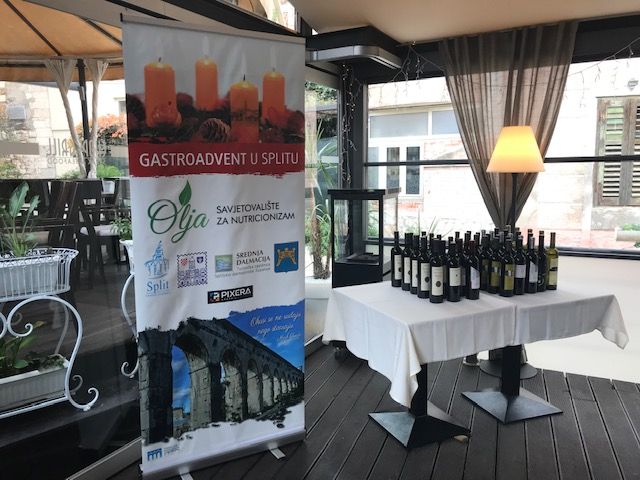
The first Advent candle for Gastroadvent was lit on Sunday at the famous Split restaurant Chops Grill Steak & Seafood. The first candle was burned by Croatian journalists and representatives of Split-Dalmatia County, including Split-Dalmatia County Tourist Board director Joško Stella, Split-Dalmatia County prefect Blaženko Boban, and Split Tourist Board director Alijana Vukšić.

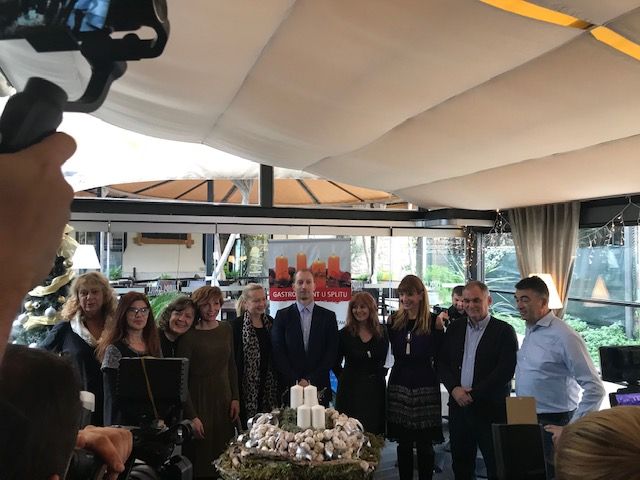
After the initial presentation of Split’s increasingly positive tourism results, Gastroadvent organizer Olja Martinic introduced the theme for this year’s favorite event: garlic and thermal water.
Specifically, this year's Gastroadvent aims to highlight the importance of consuming garlic and water and their role in the prevention and treatment of many diseases. Garlic is a plant known for its robust flavor - and it helps to know that it carries top quality culinary and medical properties.
The main ingredient in garlic is allicin, which possesses miraculous antibacterial, antiviral, anti-inflammatory, anti-parasitic and antioxidant properties. Just some of the benefits of garlic are that it stimulates circulation and acts as anti-hypertensive, anti-atherosclerotic, and anti-cholesterol, and thus promotes the formation of H2S in the body. Garlic has anti-malarial activity, especially for the digestive system and regulation of the intestinal flora - and its sulfur compounds protect against stress and act as an antioxidant!
The medicinal properties of garlic come in direct contact with the soil where it grows, and because the area around Split is rich in thermal springs, garlic, as well as other vegetables are considered extremely healthy. Thermal waters soak in the soil, making it unique for vegetation while its volatile components improve the air quality at the same time. Sulfuric thermal waters are used in therapy for dermatology, respiratory problems, and especially in chronic rheumatism and neuralgia. Sulfuric thermal water is also helpful in chronic fatigue and anti-stress programs.
Chops Grill created a stunning spread using the prized ingredients, including focaccia with garlic and rosemary, bruschetta with beefsteak, horseradish, and garlic, fried monkfish with a white garlic dip, Caesar salad, risotto with shrimp and garlic, pasta with garlic, chili and almonds, and much more.
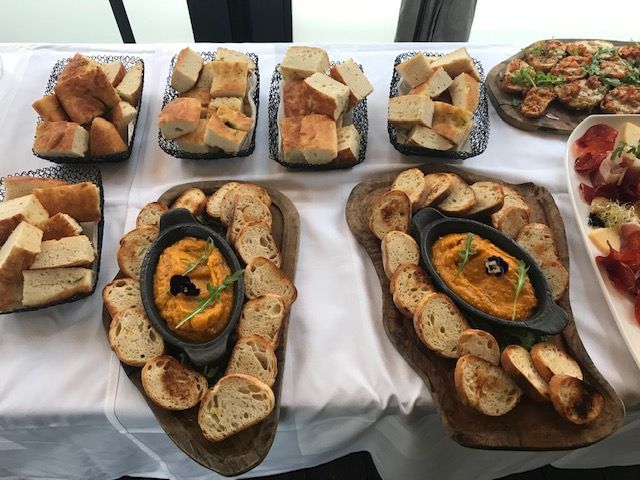
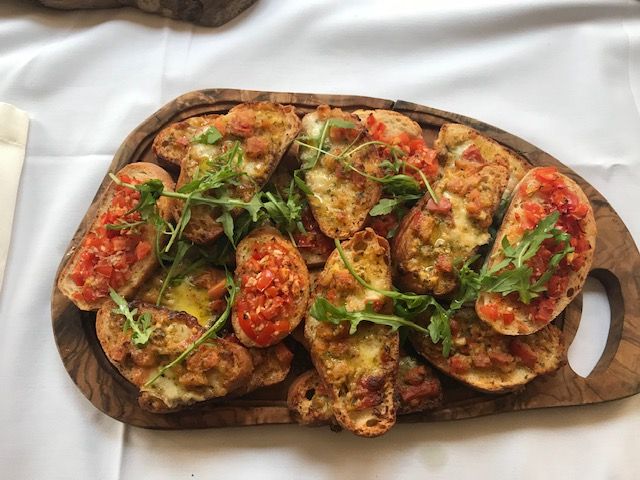
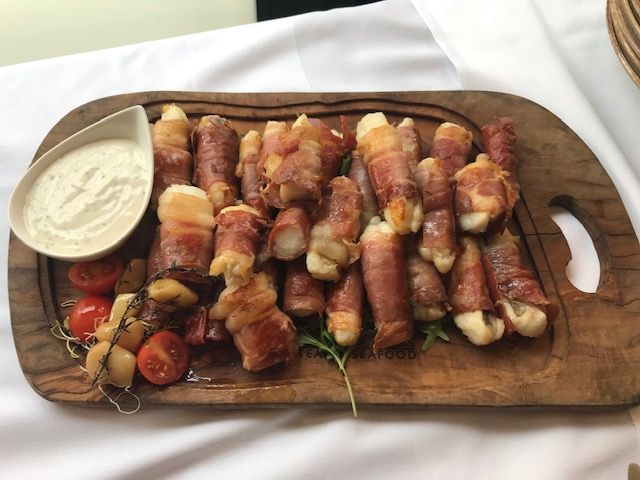



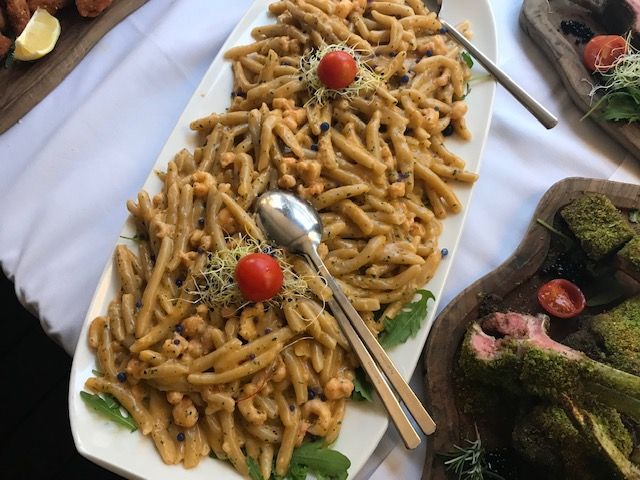
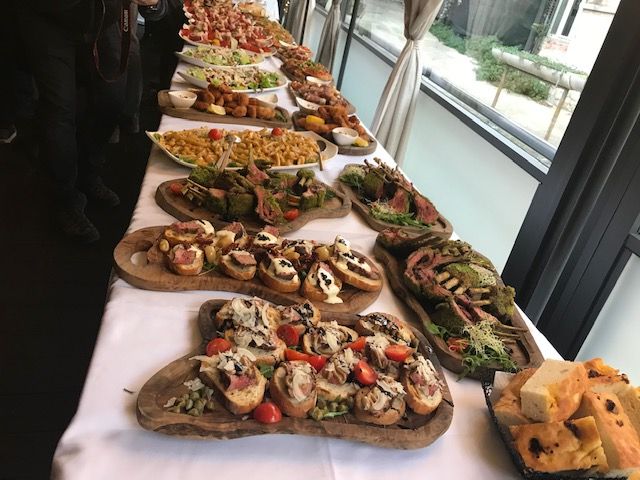


There was even a fantastic selection of wines!
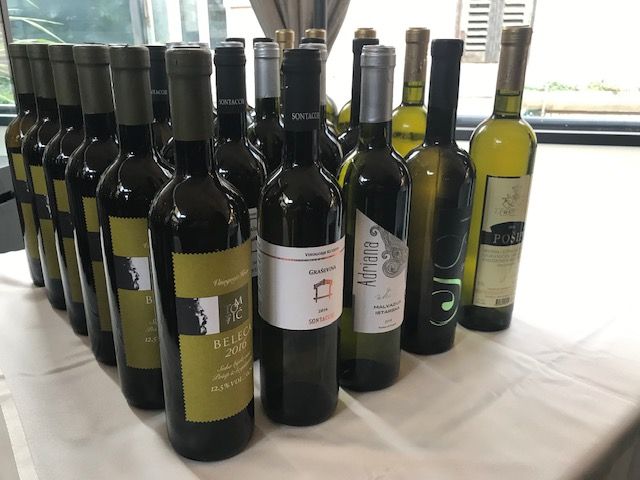
Sunday marked the 9th edition of Gastroadvent, which was inspired by the passing of journalist Maja Stanisljević.
"When we first started Gastroadvent eight years ago, a beautiful, beautiful journalist who loved the environment and gastronomy and followed all the food and beverage fairs, Maja Stanisljevic, passed away. We then sat down and agreed that journalists bring light to the city - they deserve it because they work all year long, and this is the time when the city of Split needs to be honored,” said Gastroadvent organizer Olja Martinić at last year’s event.
To learn more about Split Advent, follow TCN's dedicated page here.
Split Advent Begins: A Look at Opening Night in Photos
December 2, 2018 - Split Advent is finally here! The holiday celebration officially opened on Saturday in various locations around the city center. Thousands of locals and tourists were eager to welcome the return of the favorite festive event which marked the start of the Christmas season in the city.
Holiday houses selling mulled wine, sausages, sarma, and souvenirs were a hit, and Croatian pop star Giuliano took the stage for the opening concert on the Riva.
This year, the Riva boasts 20 houses, which is more than last year - and 12 of them are reserved for catering! Đardin will be the go-to for Split’s youngest citizens, while the new location at Gaje Bulata Square will boast four shops and the performances of street singers. Prokurative is traditionally decorated with the children's train, while the event at King Tomislav Street extends this year from the Gallery of Fine Arts to the old Post Office.
Here’s a look at Advent so far.
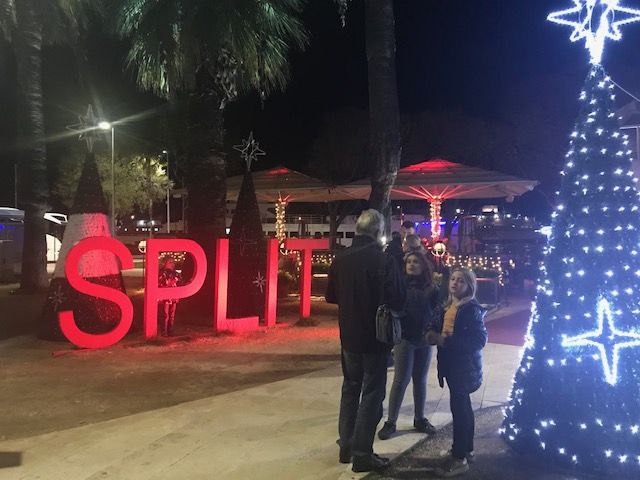
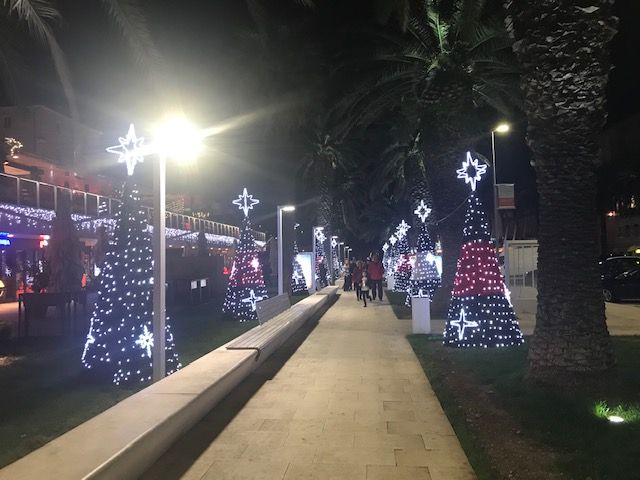
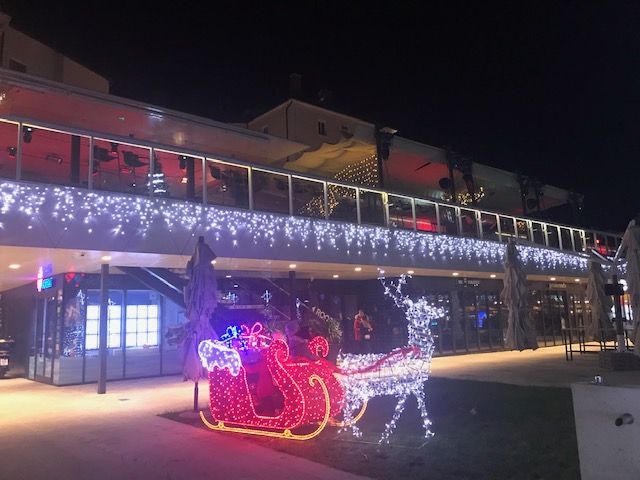


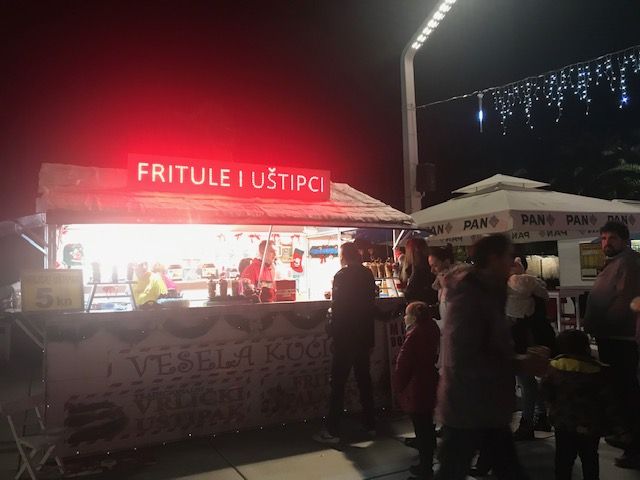

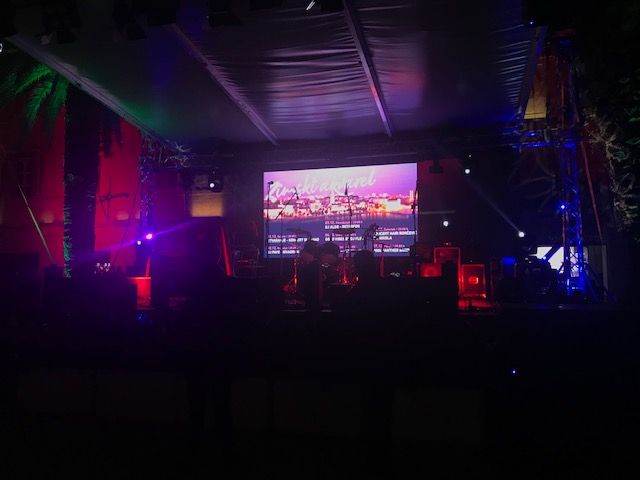
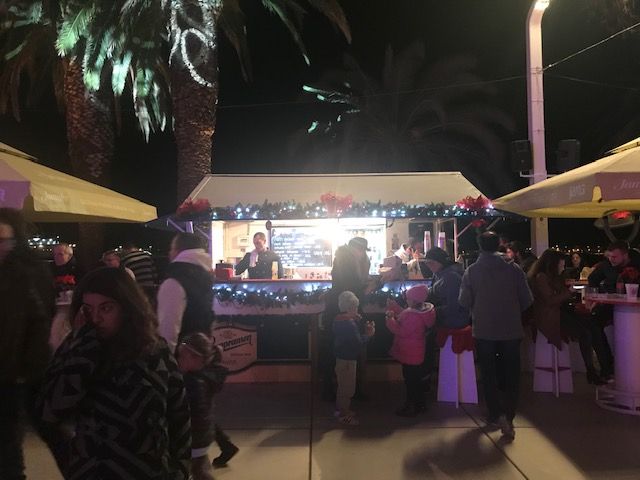
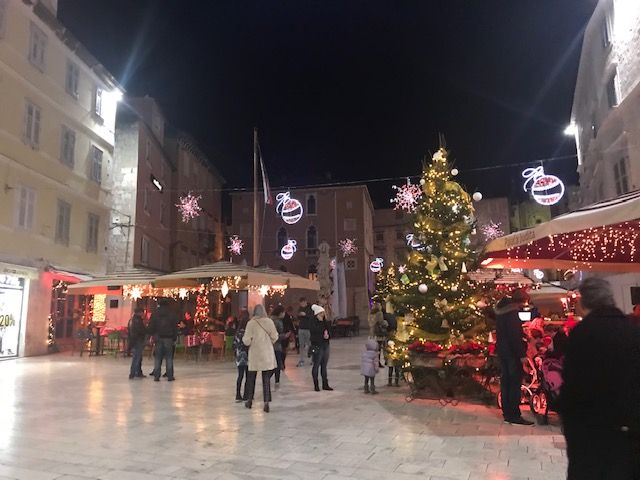

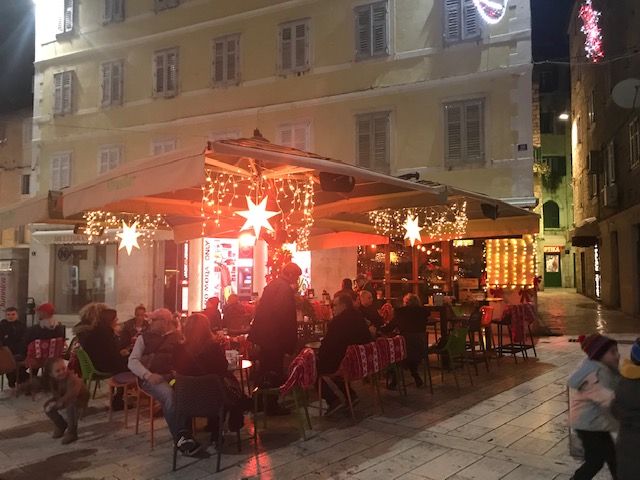
Advent will last until January 7, 2019. You can find the full schedule of events on the Split Tourist Board website here.
PS: Don't forget about the free 'Advent' bus line which will operate for the duration of the event. You can find the timetable here.
To read more about Split Advent, follow TCN's dedicated page here.
Is It Time for an International School to Open in Split?
December 1, 2018 - Despite a population of almost 200,000 and a rapidly increasing expat community, Split has no international school. Is it time to open one?
It is almost six years to the day since I started a website called Total Split, the first dedicated portal in English to that wonderful city, updated several times a day. At the time I knew very little about the city, despite having lived on the nearby island of Hvar for almost a decade. For me, Split back then was three things - transit to Zagreb and Split airport, shopping chores for my wife, and hospital visits with the kids. Oh yes, and always - but always - getting everything done before the last ferry at 20:30. About Split nightlife, I knew very little.
After the initial success of my first portal, Total Hvar, I was encouraged by a friend to start one in the big city. But surely such a thing exists, I protested, and anyway I know so little about the city. I checked and - incredibly for a tourist city that size - tourist information was very scarce in English, at least beyond the very basic stuff offered by tourist boards and agencies looking to promote their tours.
And so we began. WIth the help of young Mila (with whom we co-wrote a guidebook) and Ivica, Total Split soon blossomed, and it was a joy to get to know the city and its people in more details, as well as having more interaction with 'The Big Smoke' after so many years in sedate Jelsa. I met a young French woman living in the city who had started an Expats in Split Facebook group, and we met for coffee to see if we could work together to expand it. I had known of expats in the city since my arrival in Dalmatia back in 2002, but they were few in number. There had been an occasional monthly international food night, where expats would prepare something of their national cuisine, and some occasional 5-a-side soccer, but apart from that, the expat scene was pretty quiet. The first foreign-owned hostel opened in 2003 to give you an idea.
Expats in Split, a Growing Community
And then Split changed. Immensely. The explosion of tourism as the city transformed itself from 'the Gateway to the Islands' to one of Europe's hottest tourist destinations is one part of the story, much less reported is the rising number of expats, particularly digital nomads, relocating to Split.
Total Split's audience grew quickly, as the growing number of expats found a regular source of news. And so too, through our little site, did Helene's expat Facebook page, which had just 20 members when we sat for our first coffee in early 2014. The first Expats evening was organised at Zinfandel, a newly opened wine bar, one of the many new businesses opening in the city with the tourism boom. We had no idea how many people would come, but about 60 people turned up, coming from the islands and even as far away as Sarajevo. Here is a look back at the first night all those years ago.
(The Expats in Split gathering at Zinfandel in early 2014)
Helene's group grew, then split into two as one expat tried to take control of the group, and although I am rarely in Split these days, I do follow one of the groups, which has now grown to almost 1,800 members. It is a useful group, with several newcomers weekly asking a variety of questions about moving to Split, including the availability of international schools.
Despite a population of almost 200,000 people, a growing number of internationals living in the city and a wealthy section of local families, Split does not currently have an international school. Indeed, there are only three in all Croatia, as far as my research tells me, all located in Zagreb.
Montenegro 5 Croatia 3
I was on a business trip to both Split and Montenegro this week, meeting various people related to the TCN project. I was surprised to learn that while Croatia only has three international schools, Montenegro has five. There are three in the capital Podgorica, including a recently opened French school, a city with a population similar to Split', and there are two international schools in Tivat, a small town not far from Dubrovnik, population just 14,000. The reason for the international schools in Tivat is due to the Porto Montenegro development, of course, one which should have come to Croatia (and would have done allegedly if the required bribes to the politicians had not been so outrageous, the result being that Montenegro is now the regional port of choice for the super-rich and their mega yachts). But international schools in Dalmatia? Zero.
The Rise of Split as an International City
It is almost four years since I asked the question Is Split Finally Becoming an International City? It was becoming so back then, it is even more so now. I don't visit Split so much these days, but I had a really nice evening on Thursday, meeting a Romanian friend for a drink in the new Black Dog pub (big like). She had just come from the Australian-Croatian gathering at an international co-working space, and after a drink, we headed to Zinfandel in the old town. A very pleasant evening.
The expat community is growing, and while some services are there, there are some basic essentials required by internationals in a city still to be put in place. One of them is an international school. In Croatia, it is currently illegal to homeschool, and so the only option for families moving to Split for local education is to immerse themselves in the local system. While this aids language learning and character building, it is not for everyone. I am pretty sure that there is enough demand already for an international school in Split (and let's not forget the section of the local community who would be interested in such education options), and the establishment of an international school would significantly increase Split's attractiveness as a relocation option.

Of course, this all depends on whether we want to have foreigners in The Beautiful Croatia making a positive contribution to the economy. Not according to chaps like young Jospephine, above, whose response to our recent article on residence permit issues of American retirees prompted the assertion that Croatia has no need of American retirees or tourists, unless they are of Croatian descent. An interesting economic argument, given that American tourists will have spent about a billion euro in Croatia in 2018, or about 1.5% of GDP. But that, of course, is a different discussion.
For the latest from Split, follow TCN's dedicated portal on the Dalmatian capital.

